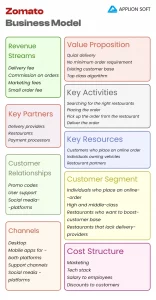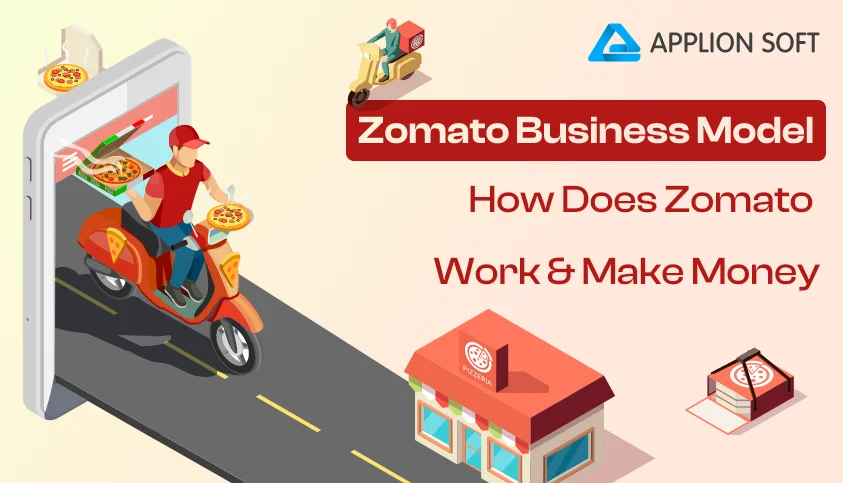In most countries, people have moved to online ordering rather than visiting restaurants physically. Online food delivery apps are quick and easy to do from anywhere, and this is the reason why millennials prefer them. In this growing world of online ordering, one Indian platform that has arisen and has grown since its launch is Zomato. Some entrepreneurs, investors and researchers want to know everything about the business model of Zomato and what secret recipe has made them so successful in this saturated market.
Zomato is one of the best food delivery apps in India which allows customers to order food online from their favorite restaurants. Small cafes to big restaurants are leveraging this platform to earn more revenue and to make their customer base strong. Indeed, Zomato is beneficial for both customers and restaurants, but did you know Zomato can make giant revenue too?
Yes, there are multiple revenue sources for Zomato and the company has now become mainstream in the Indian food delivery market. Want to know how Zomato works? What business model does it follow? About its revenue sources? To get the answers to all these, read this blog throughout. Let’s get started.
What is Zomato?
Zomato is an online platform that serves the rising needs of customers, restaurant partners, and delivery providers by connecting them to one platform. From browsing the nearest restaurant to checking reviews of previous customers to making online payments and tracking the order in real-time, Zomato makes it extremely easy for customers to get food delivered to their homes.
Launched by two IIT graduates, Deepinder Goyal and Pankaj Chaddah, in 2008, Zomato introduced its business as Foodiebay. This was the online restaurant directory that allowed users to check out restaurant menus with certain features. The idea was converted into reality and now we can see how these small ideas have changed people’s lives and made Zomato a unicorn in no time.
Over the years, Zomato has expanded its services and started operations across various countries with around 32.1 million monthly active users and a presence across 24 countries. Let’s have a look at some interesting facts and figures about Zomato before discussing its business model in detail.
Lesser Known Facts About Zomato
- Company Name: Zomato
- Formerly Known: FoodieBay (2008-2010)
- Company type: Public
- Industry: Online food ordering
- Founded in: 2008
- Founders: IIT Graduates (Deepinder Goyal & Pankaj Chaddah)
- Headquarters: Gurugram, Haryana
- Operates in: India and the United Arab Emirates
- Number of employees: 3800
- Website: https://www.zomato.com/
How Does Zomato Work?
Zomato follows a straightforward workflow and as said earlier, makes it easy for customers to get things done within an app in a couple of minutes. Let’s see how Zomato works for customers in detail.
- Customers search, find, and explore various restaurants using the website or app to place an order or reserve a table for takeout.
- After preparing the food, restaurant owners dispatch it after receiving the order request.
- The platform’s algorithm, which looks for the closest and most qualified delivery workers for the delivery, chooses a delivery partner to pick up the order.
- Delivery staff members have the freedom to accept or decline a delivery assignment; they are partners with the organization, not employees.
- The delivery companies then deliver it to the specified place after the job is accepted. Payments can be made by clients throughout the ordering process or upon delivery.
- After that, they leave reviews, which aid Zomato in enhancing its offerings and assisting other users in making wise ordering decisions.
Zomato’s delivery operating model may be summed up in three simple steps:
- Customers place orders from established restaurants and food establishments that have collaborated with Zomato using the Zomato app.
- Zomato uses its closest and most suitable delivery partner to deliver the customer’s order.
- The delivery partner and Zomato get paid commissions after delivering the order.
Zomato Business Model Explained
The “QAAA” model—which stands for “quality, affordability, accessibility, and awareness“—is the foundation of the Zomato business strategy.
The company’s main goals are to make its cuisine accessible, offer premium food at reasonable costs, and increase consumer knowledge of its name and offerings.
Zomato’s business model is built on a straightforward yet powerful idea: it serves as a middleman, facilitating communication and commercial dealings between customers and restaurants. For the business, this intermediary position has a few very important advantages.

Customer Segments
Zomato’s business model consists of three stakeholders, customers, restaurants and delivery providers. The entire business model’s customer segments can be divided into three categories. Each segment has unique needs and requirements that Zomato overcomes through its platform.
Customers
People who download the app can browse restaurants, read reviews, place an order and get them delivered to their doorsteps. People who are searching for a quick, dependable, and effective way to place food orders and find new restaurants.
Restaurants
Zomato helps restaurant managers and owners grow their internet presence, attract more customers, and boost revenue. They can display their menu, provide specials, and take orders for pickup or delivery on the platform.
Delivery Providers
Zomato works with delivery partners to complete meal orders that users place on the website. These associates consist of independent couriers and outside logistical providers. They profit from Zomato’s enormous user base as well as the chance to make money on the platform.
Zomato’s success and expansion in the meal delivery sector can be attributed to its creative business strategy, which is based on Alexander Osterwalder’s Business Model Canvas.
Zomato has revolutionized the way people find, order, and enjoy food by comprehending and catering to the specific needs of its various customer segments, developing compelling value propositions, utilizing efficient channels, cultivating strong customer relationships, and optimizing its resources, activities, partnerships, and expenses.
How Does Zomato Make Money? Zomato Revenue Model
Since its establishment, Zomato has grown to be a major force in the food sector. Its revenue in 2020 was an astounding $394 million, while that of Hyperpure increased from $1.8 million to $14.7 million in 2021. Its revenue is primarily generated by a diverse range of operations, which include:
Commission on Food Delivery
Zomato charges restaurants a commission based on orders through its food delivery service. Restaurants pay a commission to the company for each delivery, and that commission is divided between the delivery partners and the company. However, due to intense competition, the requirement to offer steep discounts, etc., and other factors, online meal delivery only makes up a small portion of revenue when compared to other revenue streams.
Advertisement
Zomato collaborates with restaurants and cafes to advertise their goods, services, and membership packages online. They are charged commissions by it for having advertising placed immediately in their feed. Additionally, Zomato charges restaurants to hold events and promote their businesses, increasing their visibility. Because brands continue to rely on the platform’s services as they grow, this brings in a significant amount of money from advertising.
White Label Access
The technology infrastructure utilized by the company to power the websites and applications of its partner restaurants is known as “white-label access.” These establishments pay a monthly subscription fee to Zomato to use its site. Table bookings, in-app purchases, and online ordering are all available on this platform.
Cloud Kitchen
Zomato provides a kitchen infrastructure solution to eateries looking to grow as cheaply as possible into new locations. This increases its revenue and attracts new restaurant partners.
Subscription Programmes
Zomato created a consistent revenue stream by offering membership options for restaurants and Zomato Gold for users and consumers.
Restaurants pay a monthly charge to be included in Zomato’s assortment of deals, in addition to users who pay a subscription fee to enter the Zomato Gold loyalty programme, which includes unique discounts. Additionally, Zomato charges restaurants a monthly fee for ancillary services like live tracking and tamper-proof packaging bearing the Zomato logo.
Launch the Zomato Like App with Applion Soft
Online food delivery apps are booming, making the overall industry promising. To launch an app like Zomato, we have presented the entire business model in a better way that enables entrepreneurs to enter the market with robust solutions. All you need to do is find a trusted technology partner who will handle all the processes and build an app like Zomato as per your business requirements.
When launching a food delivery business, a fully-featured, beautifully designed app is the most important part. The most effective way to develop a solution is to hire an experienced on-demand app development company such as Applion Soft. By working with us, you can expect a well-versed final product, as well as guidance that can help you hit the market early.
Contact us, share your requirements and we will be glad to assist you.
Frequently Asked Questions
What is the cost of developing an Uber-type laundry app?
It takes $27,000–$58,000 to develop a custom. You can launch with ApplionSoft’s white-label product for $5,000–$8,000.
How long will it take to develop the app?
6–9 months for custom apps. ApplionSoft white-label apps are live in 2–4 weeks.
Can I support more than one mode of payment?
Yes, ApplionSoft laundry apps support UPI, cards, net banking, wallets, and cash on delivery.
Do laundry apps perform well in small cities?
Yes. There are still plenty of promising smaller markets that are underserved. A well-marketed app can tap into a decent demand.
How do I scale my laundry app?
Start with one city, streamline operations, and go geographical later. Go geographically cheaply using data-driven marketing.
